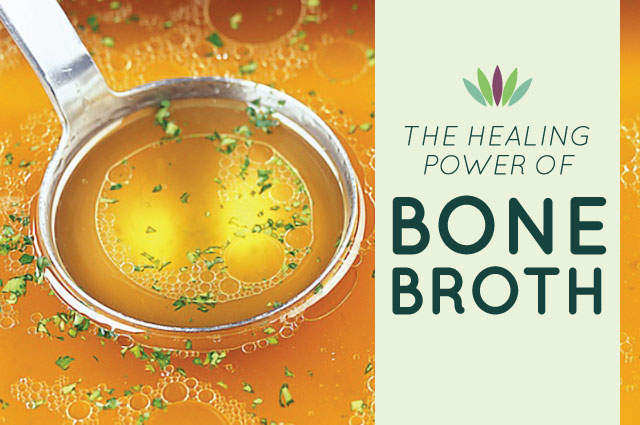Bone broths including beef, chicken, fish and lamb have been staples in the traditional diets of every culture for thousands of years. That’s because bone broths are nutrient-dense, easy to digest, rich in flavor, boost healing and promote good health.
Bone broth or stock was a way our ancestors made use of every part of an animal. Inedible bones and marrow, knuckles, skin and feet, tough meat, tendons and ligaments were boiled then simmered over a period of days. This simmering causes the bones and ligaments to release healing compounds like collagen, proline, glycine, and glutamine that have the power to transform your health.
Meat and fish stocks play a role in all cuisines around the world – French, Italian, Chinese, Japanese, African, South American and Middle Eastern. In fact, in many households and restaurant kitchens there is a never-ending stockpot, where old bones are removed and new bones are added. It’s time for you to get on the bandwagon!
Broths contain minerals in forms that your body can easily absorb: calcium, magnesium, phosphorus, silicon, sulphur and others. Broths contain chondroitin and glucosamine, pricey supplements sold to repair joints and reduce inflammation. You can toss those and just start eating bone broth. Broths contain everything you need to repair your joints. Broth and soup made with fish heads and carcasses provide iodine and thyroid-strengthening substances.
Sally Fallon and Kaayla Daniel of the Weston A. Price Foundation who are coauthoring a book on bone broths. It will contain all different kinds of recipes and explain the importance of including bone broths in your diet. Listen to this podcast I did with Kaayla Daniel. She talks mostly about soy but at the end of the podcast we discuss bone broths and her new book with Sally Fallon Morrell, Nourishing Traditions of Bone Broths.
Benefits of Bone Broth
Bone broths seem like a simple tasty liquid, but it has health benefits far beyond what you might imagine.
- Heals a leaky gut. The gelatin in bone broth protects and heals the mucosal lining of the digestive tract. The amino acid l-glutamine in bone broth is the main amino acid the gut uses to repair the intestinal lining.
- Overcome food intolerances and allergies. By healing a leaky gut you can resolve issues related to food intolerance and allergies because they are caused mainly by undigested large food particles seeping out of a leaky gut and triggering an immune response. Broth heals the gut lining, preventing this issue.
- Reduces length of colds and flu. Chicken soup during a respiratory infection reduces the number of white blood cells, which are the cells that cause flu and cold symptoms. There’s a reason that it’s prescribed by grandma when you’re feeling under the weather.
- Heals joint pain and inflammation. The glucosamine in bone broth stimulates the growth of new collagen, repairs damaged joints and reduces pain and inflammation.
- Healthy skin, hair and nails. The collagen and gelatin in bone broth results in healthy hair growth and keeps your nails strong.
- Facilitates bone formation, growth and repair. Minerals, including calcium, magnesium and phosphorus found in bone broth repairs our bones and keeps them strong.
- Fights inflammation. Bone broth is very high in the anti-inflammatory amino acids glycine and proline.
- Reduce cellulite! Consuming collagen-rich bone broth can reduce cellulite and tighten your skin making you look younger.
Collagen and Gelatin
Real collagen is the source of bone broth’s immune-boosting properties. Collagen is the protein found in connective tissue of your body and in animal’s bodies. It’s abundant in bone, marrow, cartilage, tendons, and ligaments. The breakdown of collagen in bone broths is what produces gelatin. Gelatin (the breakdown of collagen) was one of the first functional foods, used as a medical treatment in ancient China.
Dr. Francis Pottenger and other world class researchers have found gelatin and collagen to have the listed benefits:
- Gelatin helps people with food allergies and sensitivities tolerate those foods including cows milk and gluten.
- Collagen protects and soothes the lining of the digestive tract and can aid in healing IBS, Crohn’s, ulcerative colitis and acid reflux.
- Gelatin promotes probiotic balance and growth.
- Bone broth increases collagen reducing the appearance of wrinkles and banishing cellulite.
- Gelatin helps break down proteins and soothes the gut lining, proving useful for leaky gut syndrome and the autoimmune disorders that accompany it.
- Gelatin provides bone-building minerals in easily absorbable ways, preventing bone loss and reducing join pain. (3)
According to Donna Gates, author of Body Ecology, bone broth decreases the appearance of cellulite and makes your skin more supple and smooth looking! Cellulite comes from a lack of connective tissue. If someone has very smooth skin it’s because their skin is high in connective tissue. Donna explains that consuming collagen-rich bone broth can reduce cellulite and tighten your skin making you look younger. I’m in!
Healing Amino Acids
Gelatin in bone broths contain amino acids like arginine, glycine, glutamine and proline. These amino acids contribute to stock’s healing properties. Western diets, heavy on processed carbohydrates, low in quality grass-fed animal products, and devoid of homemade soups and broths, make it likely that these amino acids are deficient and need to be consumed on a regular basis. There are numerous benefits of these amino acids:
Arginine
- Immune system function and wound healing
- Production of growth hormone
- Regenerates damaged liver cells
- Production of sperm
Glycine
- Prevents breakdown of protein tissue like muscle
- Aids sleep
- Used to make bile salts and glutathione
- Helps detoxify the body of chemicals (4)
- Improves memory and performance
Proline
- Repairs leaky gut
- Regenerates cartilage and heal joints
- Reduces cellulite and makes skin more supple
Glutamine
- Heals the gut lining
- Improves metabolism and muscle building
- Fuel for cells in small intestine
How to Make Bone Broth
Stock or broth begins with bones, a few pieces of meat and fat, vegetables, salt and pepper and good water. Sally Fallon says that it’s important to use body parts that aren’t commonly found in the meat department of your grocery store, things like chicken feet, necks, knuckles, etc. The advantage of feet (ox feet, chicken feet) or tails (ox tail) is that they have a lot of connective tissue, so they make a gelatinous broth full of nourishing collagen. Ask the butcher for these parts. You’ll also want to buy animal products that you know are pasture-fed and free of antibiotics and hormones. These animals will contain for more nutrients than conventionally or even organically raised animals.
Fallon describes the essentials as bones, fat, meat, vegetables and water. If you’re making beef broth or lamb broth, some suggest you should brown the meat before putting it into a stockpot. Others prefer using raw bones. Fish and poultry are fine to put in a pot without browning first.
- Place bones into a large stock pot and cover with water.
- Discard the initial cooking water when cooking larger bones, pig, cow or other ruminant. If you don’t, your broth may have an off taste. Almost immediately, blood comes out of raw bones, especially pork bones. This may be responsible for poor tasting broths some experience. Put the heat on very low and let the water warm up gradually. After an hour the water will be almost brown. Discard this water.
- Drain your bones and cover with water. Place a lid on the stock pot.
- Add two tablespoons of apple cider vinegar to water prior to cooking. This helps to pull out minerals from the bones.
- Cook slow at low heat. Once the boil begins, reduce heat to its lowest point, so the broth simmers. Two hours simmering is enough to extract flavors and gelatin from fish broth. Larger animals take longer – 8-24 hours for broth made from chicken, turkey or duck. Beef broth requires 12-24 hours.
- Scum will rise to the surface during cooking. What may seem like fat rising to the surface is actually impurities, alkaloids, proteins called lectins and other unappetizing things coming out of the animal parts in your lovely broth. It will certainly become lovelier once you remove these elements with a spoon. One of the basic principles of broth making is removal of the scum. Otherwise the broth may have some ‘off’ flavors. Skim, skim, skim your scum.
- I recommend adding vegetables such as onions, garlic, carrots, celery and herbs like dill, thyme and parsley for added nutrient value and flavor.
Perfectionists will want to chill their broth to remove the fat. After you strain your broth, put it in the fridge for a few hours or overnight. The fat will rise to the top and you can skim it off. I frankly leave it in to have a yummy little fat source in my broth. Your choice.
Stock will keep several days in the refrigerator or may be frozen in plastic containers. Once refrigerated, your broth turns into jello – that’s because jello is made from gelatin – and gelatin is exactly what you have extracted from your bones. Good job.
Bone Broth Therapy
Forget the couch! Have some bone broth therapy! The collagen in bone broth will heal your gut lining and reduce intestinal inflammation. It will also support healthy skin and can reduce the appearance of cellulite. The glycine in bone broth can detoxify your cells from chemicals and improve brain function.
I recommend consuming 8oz (236 ml) daily as a soup, a plain beverage, or during a fast. I typically drink 8oz (236 ml) a few days a week.
Bone broths are one of the secrets to health and long life. Science validates what our grandmothers knew. It is an incredibly nutrient-rich food full of healthy fats and minerals. Stock or broth made from the bones of chicken, fish and beef builds strong bones, shorten recovery from colds and flu, and is a perfect food to eat when doing intermittent fasting or an extended fast if you need nourishment. Forget juice! Do a bone broth fast! It has more nutrients in it you require during a fast. If you are ill or nauseous, broth is the perfect nourishing recovery food.
One would be wise to make homemade broth dishes a regular part of their diet. In the US, homemade stocks are more and more rare, with many opting to use premade, boxed broths in recipes. These do not contain the flavor or life-giving nutrients and fats of homemade broths.
Avoid Boxed and Canned Broths
Sally Fallon Morell explains that most store-bought “stock and ‘broth’ today aren’t real.” Instead, they use lab-produced meat flavors found in bouillon cubes and soup mixes. Manufacturers also use monosodium glutamate (MSG), which is recognized as a meat flavor but in reality is a neurotoxin.
In the 1940’s food manufacturers discovered how to induce meat-like flavors in the laboratory with the discovery of MSG, aka monosodium glutamate. Glutamate is a protein in food that the human body recognizes as meat. MSG can fool the tongue into tasting savory, meat-like flavors. In fact, the most common receptor on the tongue and the entire body is for glutamate. MSG fools the body into thinking it is eating a satisfying, protein-rich meal. You will find it in all canned and boxed broths.
Sadly, even homemade soup in most restaurants begins with a prepackaged powdered soup base containing MSG. Be sure to inquire about how the soup is made. You will likely have to ask the chef or manager, not the server. Almost all canned soups and stews contain MSG, found in ingredients on the label called hydrolyzed proteins or yeast extract.
If you just can’t bring yourself to make broth, you can easily find real broth in higher-end restaurants. Avoid chain restaurants and mid-range restaurants where they may be using an MSG-laden powdered soup base. Ask if the soup is made from scratch without a powdered or canned mix base.
A high end restaurant’s stock is pretty much guaranteed to be wholesome and made fresh. More expensive, yes, but you get what you pay for. I relish the opportunity to eat fish broth at seafood restaurants since I don’t make that at home. I seek out restaurants that have exotic broths like oxtail soup. Regularly, I eat at Vietnamese pho restaurants to get beef broth. Go on broth safari!
In our wonderful world of technology, you can also order bone broth online!
I really like Paleo Valley’s grass-fed bone broth. There is also Kettle and Fire, Theflavorchef.com and Wisechoicemarkets.com!









